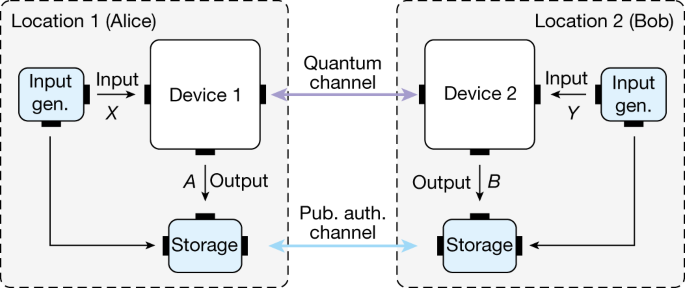2022-07-28 スイス連邦工科大学ローザンヌ校(EPFL)
暗号技術とは、メッセージを巧みに変換し、意図した相手以外には意味がないようにすることである。デジタル商取引に代表される最新の暗号方式では、敵対者に膨大な計算量を消費させる数学的操作を要求することで、クレジットカード情報などの不正な解読を防いでいる。
しかし、数十年前から、盗聴者の有限な計算能力に依存しない、独創的な理論的コンセプトが導入されている。量子物理学の基本的な法則によって、敵が最終的に傍受できる情報量を制限する。
量子鍵配送と呼ばれるこのような概念では、使用する物理装置に関するいくつかの一般的な仮定だけで安全性を保証することができるが、現実的にはまだ手の届かないところにある。今回、国際研究チームが、この種のプロトコルを初めて実証し、このような高度なセキュリティを実現する装置の実用化に向けた決定的な一歩を踏み出したと『Nature』誌に発表しています。
Ekertの先駆的な提案に基づき、これらの脆弱性を排除した完全な量子鍵配送プロトコルを実験的に実現しました。理論的な開発と、2つのトラップドイオン量子ビット間にエンタングルメントを生成する改良型光ファイバーリンクを組み合わせることにより、8時間の実行時間で作成した150万個のベルペアから、デバイスに依存しないセキュリティを持つ鍵ビットを得ることに成功した。
<関連情報>
- https://actu.epfl.ch/news/a-key-role-for-quantum-entanglement/
- https://www.nature.com/articles/s41586-022-04941-5
ベルの定理で証明された実験的量子暗号鍵配布法 Experimental quantum key distribution certified by Bell’s theorem
D. P. Nadlinger,P. Drmota,B. C. Nichol,G. Araneda,D. Main,R. Srinivas,D. M. Lucas,C. J. Ballance,K. Ivanov,E. Y.-Z. Tan,P. Sekatski,R. L. Urbanke,R. Renner,N. Sangouard &J.-D. Bancal
Nature Published27 July 2022
DOI:https://doi.org/10.1038/s41586-022-04941-5

Abstract
Cryptographic key exchange protocols traditionally rely on computational conjectures such as the hardness of prime factorization1 to provide security against eavesdropping attacks. Remarkably, quantum key distribution protocols such as the Bennett–Brassard scheme2 provide information-theoretic security against such attacks, a much stronger form of security unreachable by classical means. However, quantum protocols realized so far are subject to a new class of attacks exploiting a mismatch between the quantum states or measurements implemented and their theoretical modelling, as demonstrated in numerous experiments3,4,5,6. Here we present the experimental realization of a complete quantum key distribution protocol immune to these vulnerabilities, following Ekert’s pioneering proposal7 to use entanglement to bound an adversary’s information from Bell’s theorem8. By combining theoretical developments with an improved optical fibre link generating entanglement between two trapped-ion qubits, we obtain 95,628 key bits with device-independent security9,10,11,12 from 1.5 million Bell pairs created during eight hours of run time. We take steps to ensure that information on the measurement results is inaccessible to an eavesdropper. These measurements are performed without space-like separation. Our result shows that provably secure cryptography under general assumptions is possible with real-world devices, and paves the way for further quantum information applications based on the device-independence principle.



